When it comes to savoring the rich flavors and complex aromas of fine wines, one crucial aspect often gets overlooked – the ideal serving temperature. Whether you’re a seasoned connoisseur or just starting to explore the world of wine, understanding the perfect temperature for different varieties can elevate your drinking experience and unlock the full potential of each bottle. From the bold, full-bodied reds to crisp, refreshing whites and the increasingly popular oranges, every type of wine has its own sweet spot when it comes to serving temperature.

Mastering Wine Serving Temperatures
When it comes to enjoying wine, the serving temperature can greatly impact the overall experience.
-
Red Wines:
- Bordeaux-style red blends: 65°F – 68°F (18°C – 20°C)
- Cabernet Sauvignon: 58°F – 62°F (14°C – 17°C)
- Merlot: 55°F – 60°F (13°C – 16°C)
- Pinot Noir: 50°F – 55°F (10°C – 13°C)
-
White Wines:
- Chardonnay: 45°F – 52°F (7°C – 11°C)
- Riesling: 40°F – 48°F (4°C – 9°C)
- Sauvignon Blanc: 45°F – 50°F (7°C – 10°C)
- Pinot Grigio: 45°F – 50°F (7°C – 10°C)
-
Sparkling Wines:
- Champagne: 43°F – 46°F (6°C – 8°C)
- Prosecco: 42°F – 44°F (6°C – 7°C)
-
Dessert Wines:
- Port: 55°F – 60°F (13°C – 16°C)
- Sherry: 55°F – 60°F (13°C – 16°C)
- Moscato: 45°F – 50°F (7°C – 10°C)
By understanding the ideal serving temperatures for different types of wine, you can enhance your wine-drinking experience and impress your friends and family.
At Fine Vines , we’re dedicated to helping you master the art of wine appreciation.
Unlocking the Perfect Wine Serving Temperature
As a wine enthusiast, I’m always eager to discover the secrets behind elevating my wine-tasting experience.
- The ideal temperature for savoring your favorite glass of wine depends on several factors, including the type of wine, its age, and personal preference.
- For red wines, a temperature range between 55°F and 65°F (13°C and 18°C) is generally considered optimal, allowing the complex flavors and tannins to unfold.
- White wines, on the other hand, typically require a cooler temperature, ranging from 45°F to 55°F (7°C to 13°C), to preserve their crisp acidity and delicate aromas.
- Sparkling wines, such as champagne, are usually served chilled, around 40°F to 50°F (4°C to 10°C), to enhance their effervescence and refreshing qualities.
When it comes to specific wine varieties, here are some general guidelines:
- Pinot Noir: 50°F to 60°F (10°C to 15°C)
- Merlot: 55°F to 65°F (13°C to 18°C)
- Cabernet Sauvignon: 60°F to 70°F (15°C to 21°C)
- Chardonnay: 45°F to 55°F (7°C to 13°C)
- Riesling: 45°F to 55°F (7°C to 13°C)
Remember, these are general recommendations, and the perfect temperature may vary depending on individual preferences and the specific bottle of wine.
At Fine Vines, we recommend experimenting with different temperatures to find your ideal sweet spot and unlock the full flavor potential of your favorite wines.
Visit our website for more wine education resources and expert advice on wine pairing, storage, and serving techniques.

How Does Serving Temperature Affect the Flavor and Aroma of Different Types of Wine?
The ideal serving temperature for wine can greatly impact its flavor and aroma, making it essential to understand the optimal temperature ranges for various types of wine.
- Red Wines: Typically served between 55°F and 65°F (13°C and 18°C), red wines benefit from a slightly cooler temperature to preserve their tannins and fruit flavors.
- White Wines: Usually served between 45°F and 55°F (7°C and 13°C), white wines require a chillier temperature to enhance their crisp acidity and citrus notes.
- Dessert Wines: Often served between 40°F and 50°F (4°C and 10°C), dessert wines benefit from a colder temperature to balance their sweetness and complexity.
When serving wine, it’s crucial to consider the type of grape, aging process, and personal preference when determining the ideal temperature. For example, a young Cabernet Sauvignon may benefit from a warmer temperature, while an older Chardonnay might prefer a cooler temperature.
Why Serving Temperature Matters:
Serving temperature affects the chemical composition of wine, influencing the release of volatile compounds and the perception of flavors and aromas. A temperature that’s too high can cause the wine to become flabby and lose its acidity, while a temperature that’s too low can result in a wine that tastes dull and lifeless.
Tips for Achieving the Perfect Serving Temperature:
To ensure the perfect serving temperature, consider the following tips:
- Store wine in a cool, dark place to prevent temperature fluctuations.
- Use a wine refrigerator or a temperature-controlled storage unit.
- Chill white wines in the refrigerator for at least 30 minutes before serving.
- Allow red wines to breathe for 15-30 minutes before serving.
By understanding the ideal serving temperature for different types of wine and taking steps to achieve it, you’ll be able to unlock the full potential of your favorite wines and enjoy a more nuanced and enjoyable drinking experience.

Optimal Serving Temperature Range for Each Type of Wine
Serving wine at the correct temperature can elevate its flavors and aromas, making it a crucial aspect of wine appreciation.
- Red Wines: Typically served between 55°F and 65°F (13°C and 18°C), depending on the specific grape variety and aging process.
- White Wines: Usually served between 45°F and 55°F (7°C and 13°C), taking into account factors like acidity levels and sweetness.
- Sparkling Wines: Chilled to perfection around 40°F to 50°F (4°C to 10°C), ideal for preserving the delicate bubbles and crisp acidity.
- Dessert Wines: Often served slightly warmer, between 55°F and 65°F (13°C and 18°C), to balance the sweetness and complexity.
- Rosé Wines: Typically served between 45°F and 55°F (7°C and 13°C), reflecting the wine’s light and refreshing nature.
When it comes to specific wine varieties, consider the following general guidelines:
- Cabernet Sauvignon: Serve between 60°F and 65°F (16°C and 18°C).
- Chardonnay: Optimal temperature ranges from 45°F to 55°F (7°C to 13°C).
- Merlot: Serve between 55°F and 60°F (13°C and 16°C).
- Pinot Grigio: Ideal temperature range is between 45°F and 50°F (7°C and 10°C).
- Sauvignon Blanc: Typically served between 45°F and 55°F (7°C and 13°C).
Remember, personal taste plays a significant role in determining the perfect serving temperature for individual wines. Experiment with different temperatures to find your preferred level of enjoyment.
For a more immersive wine experience, consider investing in a wine fridge or a temperature-controlled wine storage unit. These devices allow you to store and serve your wines at precise temperatures, ensuring optimal flavor and aroma expression.
At Fine Vines , we’re dedicated to helping you unlock the full potential of your wine collection. Visit our website for expert wine advice, wine reviews, and educational resources to enhance your wine journey.
Unlocking Flavor Potential: The Perfect Wine Serving Temperature for Chardonnay, Merlot, and Pinot Grigio
Discover the secret to unlocking the full flavor potential of Chardonnay, Merlot, and Pinot Grigio – find out the perfect wine serving temperature to elevate your next wine night.
- The ideal serving temperature for Chardonnay ranges between 45°F and 55°F (7°C and 13°C), allowing its buttery and oaky flavors to shine through.
- Merlot, on the other hand, prefers a slightly warmer temperature between 58°F and 65°F (14°C and 18°C), which brings out its plum and blackberry notes.
- Pinot Grigio, known for its crisp acidity, excels at temperatures between 45°F and 50°F (7°C and 10°C), highlighting its citrus and floral characteristics.
When it comes to wine serving temperature, understanding the optimal range can significantly impact the overall drinking experience. A wine served too cold may mute its flavors, while a wine served too warm may become overpowering.
At Fine Vines, we recommend experimenting with different temperatures to find the perfect balance for your favorite wines. By doing so, you’ll unlock the full flavor potential of Chardonnay, Merlot, and Pinot Grigio, making every wine night a memorable occasion.
For a more in-depth exploration of wine serving temperatures, visit our wine tasting guides section, where you’ll discover expert advice and insider tips on how to elevate your wine game.
Whether you’re a seasoned connoisseur or just starting your wine journey, remember that the perfect serving temperature is just the beginning. Experiment, explore, and enjoy the world of wine with us!

Optimizing Wine Serving Temperature for Enhanced Flavor Profile
As a wine enthusiast, I’ve always been fascinated by the impact of serving temperature on the overall drinking experience.
- The ideal serving temperature for wine can greatly affect its flavor profile, aroma, and overall enjoyment.
- A well-chilled white wine can bring out crisp acidity and citrus notes, while a slightly warmer red wine can reveal rich fruit flavors and smooth tannins.
- However, serving wine at the wrong temperature can lead to a disappointing taste experience.
Understanding Wine Temperature Zones
Wine can be broadly categorized into three temperature zones:
- White wines: Typically served between 45°F and 55°F (7°C and 13°C), depending on the style and sweetness level.
- Red wines: Usually served between 55°F and 65°F (13°C and 18°C), with full-bodied reds requiring a slightly warmer temperature.
- Dessert wines: Often served chilled, around 40°F to 50°F (4°C to 10°C), to balance sweetness and acidity.
Factors Affecting Optimal Serving Temperature
Several factors influence the optimal serving temperature for wine:
- Vintage: Older wines may benefit from a cooler temperature to preserve delicate flavors, while younger wines can handle warmer temperatures.
- Grape variety: Different grape varieties have unique temperature requirements, such as Pinot Grigio preferring cooler temperatures and Syrah/Shiraz enjoying warmer conditions.
- Oaking and aging: Wines aged in oak barrels or with extended barrel aging may require a slightly warmer temperature to showcase complex flavors.
Practical Tips for Achieving Ideal Serving Temperatures
To optimize your wine serving temperature, consider the following:
- Invest in a wine fridge or chiller: These devices allow precise temperature control and can store multiple bottles at optimal temperatures.
- Use a thermometer: Monitor the temperature of your wine storage area or serving environment to ensure consistency.
- Experiment and adjust: Pay attention to how different temperatures affect the flavor and aroma of various wines, and adjust accordingly.
Conclusion
By understanding the ideal serving temperature for wine and considering various factors, you can elevate your wine-drinking experience and appreciate the nuances of different varietals.
0 Comments